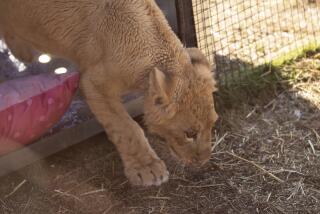At Last, a Display of Compassion
PARIS — Nearly two centuries after she was taken to Europe, sold to an animal trainer and exhibited naked like a circus freak, an African woman has finally regained some of her stolen dignity.
Saartjie Baartman’s skeleton and bottled organs--long stored at a French natural history museum--were turned over to South African officials last week at a ceremony in Paris. The event was the culmination of years of requests by countrymen who wanted to bring her home.
Drummers beat on marimbas and young women in face paint and African garb sang gospel songs at the ceremony at the South African embassy. Officials had draped a white wooden box containing Baartman’s remains with a jewel-toned African cloth.
Thuthukile Skweyiya, South Africa’s ambassador to France, said Baartman has become a symbol in her native country, “the symbol of a nation’s need to confront and acknowledge its past, and of a nation’s overwhelming desire to restore and reaffirm dignity and honor to all its people.”
Baartman has also been a symbol of the cruelty of racism, sexism and colonialism.
She was called the “Hottentot Venus,” a derogatory reference both to her roots and to her large buttocks and sexual organs, which made her the subject of crude fascination. Baartman was brought to Europe in the early 19th century, and likely believed that she would make her fortune there.
But Baartman died in poverty in 1816, after being exhibited in London and Paris as a curiosity for six years.
During shows in London, she was ordered to emerge from a cage like a wild beast. In Paris, she was sold to an animal trainer. She also was paraded before high society at balls, and once was dressed only in feathers.
After Baartman’s death, a famous surgeon made a cast of her body, dissected her and conserved her brain and genitalia in bottles of formaldehyde.
The painted plaster cast of Baartman’s body was displayed in Paris’ Musee de l’Homme until 1974, when it was stashed in a back room along with her remains.
Since the end of apartheid, Khoisan people--South Africa’s first inhabitants--have been searching for their lost heritage and wanted to get their native daughter back.
Former South African President Nelson Mandela brought up the subject of Baartman in 1994 during an official visit by former French President Francois Mitterrand.
But the return of Baartman’s remains raised difficult questions in France, including whether it would set a precedent for countries seeking the return of artifacts. It was only this year that French lawmakers voted to return the remains to South Africa, with one prominent deputy calling it a “duty of memory.”
French Research Minister Roger-Gerard Schwartzenberg said France is “willing to return human remains to every country that asks,” because human remains cannot be state property.
Baartman’s remains, as well as the cast of her body, are to be stored in a South African military hangar until a funeral is organized in August or September.
More to Read
Sign up for Essential California
The most important California stories and recommendations in your inbox every morning.
You may occasionally receive promotional content from the Los Angeles Times.








